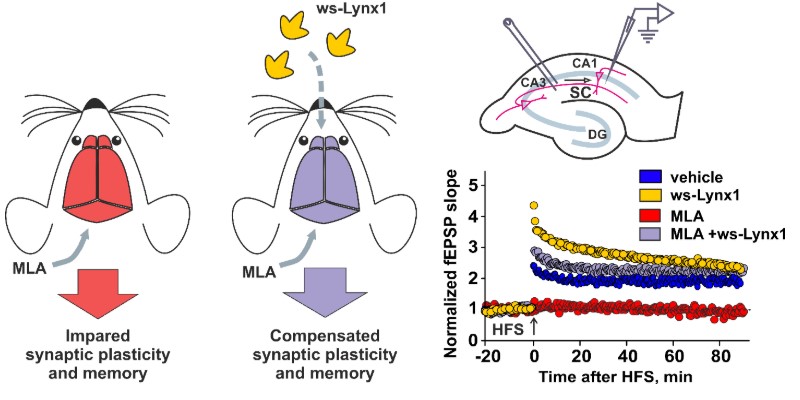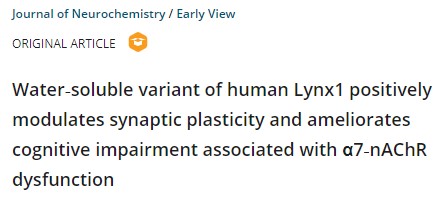Press-room / news / Science news /
Soluble Variant of Human Lynx1 Positively Modulates Synaptic Plasticity and Ameliorates Cognitive Impairment Associated with α7-nAChR Dysfunction
Scientists from the Laboratory of bioengineering of neuromodulators and neuroreceptors, the Laboratory of structural biology of ion channels and the Laboratory of neuroreceptors and neuroregulators Shemyakin-Ovchnnikov Institute together with colleagues from the Faculty of biology of Moscow State University and other russian scientific institutes, found that the intranasal administration of the water-soluble analogue of the human neuromodulator Lynx1 can prevent cognitive impairment associated with dysfunction of the α7 type nicotinic acetylcholine receptor.
Lynx1 is a GPI-tethered regulatory protein colocalized with nicotinic acetylcholine receptors (nAChRs) in the brain regions responsible for learning and memory (cortex, hippocampus, cerebellum). The water-soluble Lynx1 variant lacking GPI-anchor (ws-Lynx1) was studied. At submicromolar concentrations, ws-Lynx1 potentiates α7-nAChRs in the rat primary visual cortex L1 interneurons. At higher concentrations, ws-Lynx1 inhibited α7-nAChRs with IC50 50 µM. In C57BL/6 mice, ws-Lynx1 penetrated the blood-brain barrier upon intranasal administration and accumulated in the cortex, hippocampus, and cerebellum. Chronic ws-Lynx1 treatment prevented the olfactory memory, motor learning, and synaptic plasticity impairment induced by inhibition of α7-nAChR function.
Moreover, for the first time a quantitative estimation of the basal expression of α7-nAChR and endogenous Lynx1 in various brain regions was performed, and their association in the mouse brain was shown. “Our results demonstrate that endogenous Lynx1 is expressed in the brain in large amounts (mean concentration of this neuromodulator in the brain according our estimates is about 30 µM, that is close to the concentration required for the α7-nAChR inhibition.) Meanwhile, Lynx1 concentration exceeds the receptor concentration several times. We propose, that endogenous Lynx1 limits α7-nAChRs activation in the adult brain. Treatment with the water-soluble variant of the neuromodulator leads to partial displacement of endogenous Lynx1 normally associated with nAChRs. As a result, the nicotinic receptors can remain in unliganded form for prolonged time, and their activation by endogenous acetylcholine results in enhanced cholinergic signaling, causing positive modulation of α7-nAChRs and enhancement of synaptic plasticity. Thus, ws-Lynx1 and similar compounds may constitute useful hits for treatment of cognitive deficits associated with the cholinergic system dysfunction”, - says the Head of the Bioengineering of Neuromodulators and Neuroreceptors Laboratory, Professor Ekaterina Lyukmanova.
The work is published in the Journal of Neurochemistry (IF 4.87, Q1) under support of Russian Science Foundation.

june 1, 2020


